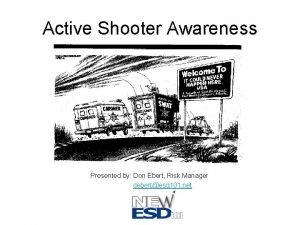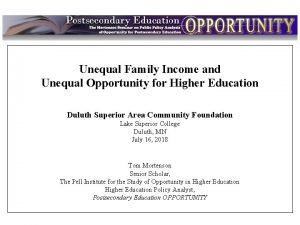How unequal are lifetime earnings Wealth Other outcomes










- Slides: 10

How unequal are lifetime earnings? Wealth? Other outcomes?

Life cycle model money wealth earnings savings consumption borrowing dissaving work starts retirement death time

Income is important, but so are many other inequalities Wealth • young people are less likely to own a house and have less pension saving Health • Health disparities are more pronounced in several countries Participation in the community and family life is declining • Less educated and low income people are less likely to be in stable family and community situations Access to the justice and political systems • is restricted for some members of society

US Deaths of Despair In the US mortality is rising amongst US white non-hispanics (USW) • particularly amongst lower educated • and middle aged (45 -54) Not true for US hispanics (USH) or in France (FRA), Germany (GER), Canada (CAN), Australia (AUS), and Sweden (SWE) Mortality has stopped falling in the United Kingdom (UK) All-cause mortality for USW aged 45– 54 Source: Anne Case, and Angus Deaton PNAS 2015; 112: 49: 15078 -15083

US Deaths of Despair Rapidly rising mortality by • poisoning, • suicide, • chronic liver disease, • and cirrhosis amongst US white non-Hispanics • particularly low educated by 5 -year age group Source: Anne Case, and Angus Deaton PNAS 2015; 112: 49: 15078 -15083

UK: Deaths of Despair are increasing putting an end to decade of falling mid-age mortality Men Women 450 400 Deaths per 100, 000 population 400 350 300 250 All deaths 200 150 All deaths 350 300 250 200 150 Cancer 100 Note: Classification of disease groups follows Case and Deaton (2015 and 2017). Source: Joyce and Xu, 2019 Heart disease 50 2017 2011 2005 0 Deaths of despair 1993 2017 2011 Deaths of despair 2005 0 1993 50 1999 Heart disease 1999 100

In the UK the gap in life expectancy between affluent and deprived areas has widened Female life expectancy at birth by IMD decile, 2001 and 2016 gap: 7. 9 years 2001 gap: 6. 1 years Source: Bennett et al. , 2018.

Family structures and communities are changing, particularly for less educated and lower income Less educated and low income people are increasingly less likely to be in stable family situations relative to more educated and richer peers Share 40 -45 s who are married or cohabiting, 1993– 2018 84% Degree-level qualification 82% 80% 78% 76% Below degree-level or no qualification 74% 72% 70% 1993 1996 1999 Note: Excludes people currently in full-time education. Source: Joyce and Xu, 2019 2002 2006 2009 2012 2015 2018

Family structures and communities are changing, particularly for less educated and lower income Less educated and low income people are increasingly less likely to be in stable family situations relative to more educated and richer peers In the UK and US, a high proportion of children are born into households with no fathers, particularly among less educated or low income groups Inequalities in childhood skills emerge at young ages, have increased in recent years, drive important later life outcomes • Widening disparities in health, earnings, family stability and parental investment in children is likely to increase inequality in children’s skills in the next generation

Geographic inequality is increasing, and with it political polarisation Economic outcomes in regions in Europe started to diverge around the 1980 s • Educated people are increasingly moving to cities, leaving the less educated behind in towns and rural areas Support for populist parties is concentrated in areas that have seen economic stagnation and decline • In several countries, local labour markets hit by import competition have increasingly voted for populist and nativist parties or candidates • The shift is cultural, not just economic. Voters in these areas become less supportive of democracy and liberal values and more opposed to immigration • In the US, trade shocks disproportionately push voters towards extreme Republicans, whose policies (favouring tax cuts on the rich and less redistribution) seem to run counter to their economic interests
 Insidan region jh
Insidan region jh Self-initiated other-repair
Self-initiated other-repair Scheduling is only available with lifetime budgets
Scheduling is only available with lifetime budgets Fittness training
Fittness training Bath assessment active shooter
Bath assessment active shooter Lifetime fitness
Lifetime fitness Get tombstone lifetime powershell
Get tombstone lifetime powershell As you climb the stairway to lifetime fitness
As you climb the stairway to lifetime fitness Lifetime guarantee
Lifetime guarantee Cisco 3750x warranty
Cisco 3750x warranty Spousal lifetime access trust diagram
Spousal lifetime access trust diagram



















